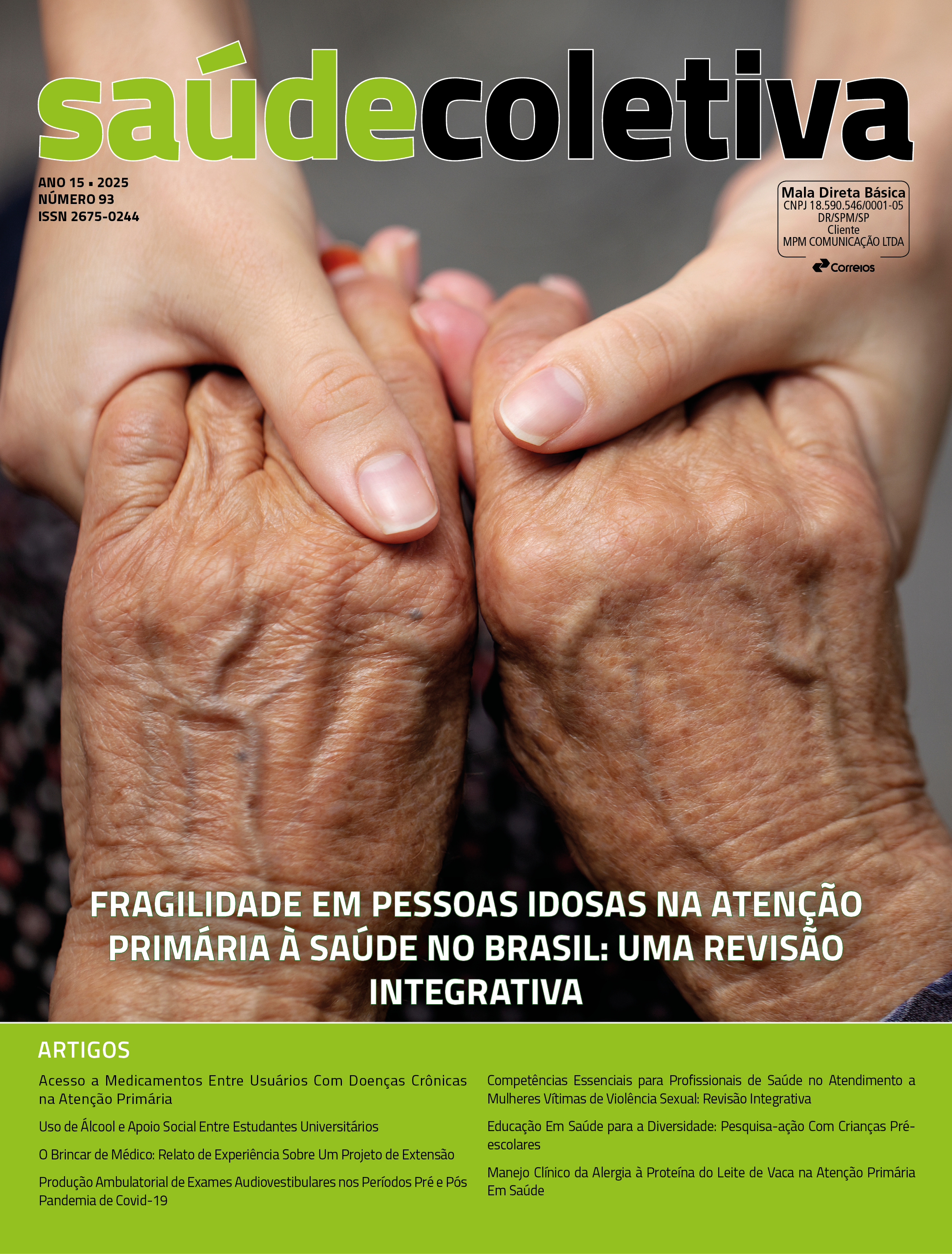Association Between Temperature and Humidty with Mortality: and Ecologial Study
DOI:
https://doi.org/10.36489/saudecoletiva.2025v15i93p14492-14507Keywords:
Mortality, Respiratory diseases, Temperature, Humidity, Climate ChangeAbstract
The objective of this study was to analyze the association between temperature and humidity, in relation to deaths from cardiovascular and pulmonary diseases in the municipality of Ribeirão Preto, SP, in 2019, projecting future scenarios of these variables. An ecological study was carried out in which deaths were classified according to Chapters IX and X of the International Classification of Diseases-10, according to death certificates and temperature and humidity data. Chapter IX represented 23% and Chapter X 24.9% of the deaths, with 53% being male, 84% over 80 years old, and 83.2% white. The highest coefficient was in the Center (5.8/1000 inhabitants), and June had the highest number of deaths (242). Temperatures ranged from 3.9ºC to 39ºC and humidity from 37% to 96.5%. Low temperatures and humidity were associated with an increase in mortality, with an increase in these variables reducing deaths by 3.1% weekly. Ribeirão Preto has a hot and dry climatological profile, with deaths mainly due to respiratory diseases.
References
Intergovernment Pannel on Climate Change (IPCC), 2022. Climate Change 2022: Impacts, Adaptation and Vulnerability. Contribution of Working Group II to the Sixth Assessment Report of the Intergovernmental Panel on Climate Change [Pörtner HO, Roberts DC, Tignor M, Poloczanska ES, Mintenbeck K, Alegría A, Craig M, Langsdorf S, Löschke S, Möller V, Okem A, Rama B (eds)]. Cambridge University Press. Cambridge University Press, Cambridge UK and New York NY, USA, 3056 pp.
Costello A, Abbas M, Allen A, Ball A, Bell S, Bellamy R, Friel S, Gace Net al. Managing the health effects of climate change. Lancet, 2009; 373(9676):1693-733. https://doi.org. 10.1016/S0140-6736(09)60935-1.
Ripple WJ, Wolf C, Gregg JW, Levin K, Rockström J, Newsome TM, Betts MG, Huq S, et al. World Scientists’ Warning of a Climate Emergency. BioScience; 2022; XX:1-7. https://doi.org/10.1093/biosci/biac083
Vicedo-Cabrera AM, Gou Y, Sera F, Huber V, Schleussner C, Mitchel D, Tong S, Sousa M, et al. Temperature-related mortality impacts under and beyond Paris Agreement climate change scenarios. Climate Change. 2018; 150(3-4):391-402. https:// 10.1007/s10584-018-2274-3
Silveira IH, Cortes TR, Oliveira BFA, Junger WL. Projections of excess cardiovascular mortality related to temperature under different climate change scenarios and regionalized climate model simulations in Brazilian cities. Environ Res,2021;197:110995. https:// 10.1016/j.envres.2021.110995
Silva I. Relação da temperatura e da umidade relativa com internações e mortes por doenças cardiovasculares, respiratórias e distúrbios mentais. [dissertação de mestrado]. Londrina: Universidade Tecnológica Federal do Paraná (UFTPR); 2020.
Gou Y, Wen B, Wu Y, Xu R, Li S. Extreme temperatures and mortality in Latin America: Voices are needed from the Global South. Med. 2022; 3(10), 656-660. https://10.1016/j.medj.2022.09.004.
Dimitrova A, Ingole V, Basagaña X, Ranzani O, Milà C, Ballester J, Tonne C. Association between ambient temperature and heat waves with mortality in South Asia: systematic review and meta-analysis. Environ Int, 2021;146:106170. http:// 10.1016/j.envint.2020.106170
Jacobson LSV, Oliveira BFA, Schneider R, Gasparrini A, Hacon SS. Mortality risk from respiratory diseases due to non-optimal temperature among Brazilian elderlies. Int J Environ Res Public Health. 2021;18(11):5550. https://10.3390/ijerph18115550.
Organização Mundial da Saúde. CID-10 /Organização Mundial da Saúde; tradução Centro Colaborador da OMS para Família de Classificações Internacionais em Português- 8 ed. rev. e ampl., 2ª reimpr. - São Paulo. Editora da Universidade de São Paulo, 2012.
Companhia Ambiental do Estado de São Paulo (Cetesb). Dados Horários. [internet]. [acess in 15 ago 2021]. Available in: https://cetesb.sp.gov.br/ar/dados-horarios/.
Instituto Brasileiro de Geografia e Estatística. Base de Informações do Censo Demográfico 2010: Resultados do Universo por Setor Censitário. [internet]. [acess in 4 ago 2020]. Available in: http://downloads.ibge.gov.br/downloads_estatisticas.htm.
Cameron AC, Trivedi PK. Regression Analysis of Count Data. New York: Cambridge Press, 1998.
BRASIL. Lei 13.709, de 14 de agosto de 2018. Lei Geral de Proteção de Dados. [internet]. [acess in 22 apr. 2022] Available in: http://www.planalto.gov.br/ccivil_03/_ato2015-2018/2018/lei/l13709.htm.
Gasparrini A, Gou Y, Hashizume M, Lavigne E, Zanobetti A, Schwartz J, Tobias A, Tong S, et al. Mortality risk attributable to high and low ambient temperature: a multicountry observational study. Lancet. 2015; 386(9991):369-375. http://dx.doi.org/10.1016/S0140-6736(14)62114-0.
Son J, Gouveia N, Bravo MA, Freitas CU, Bell ML. The impact of temperature on mortality in a subtropical city: effects of cold, heat, and heat waves in São Paulo, Brazil. Int J Biometeorol, 2016; 60:113-121. https://doi.org/10.100s00484-015-1009-7.
Xu X, Chen Z, Hou X, Wang, C, Li N, Meng X, Weng Q, Liu Q, et al. The effects of temperature on human mortality in a Chinese city: burden of disease calculation, attributable risk exploration, and vulnerability identification. Int J Biometeorol, 2019; 63:1319-1329. https://doi.org/10.1007/s00484-019-01746-6.
Cheng J, Xu Z, Bambrick H, Su H, Tong S, Hu W. Impacts of heat, cold, and temperature variability on mortality in Australia, 200-2009. Science of the Total Environment. 2019; 651:2558-2565. https://doi.org/10.1016/j.scitotenv.2018.10.186.
Fundação Sistema Estadual de Análise de Dados (SEADE). Em 2020, a esperança de vida diminuiu um ano. Seade informa- Demografia. [online]. [acess in 5 apr. 2021] Available in: https://informa.seade.gov.br/2020-esperanca-vida-diminuiu-um-ano/.
United Nations, Department of Economic and Social Affairs, Population Division. World Population Ageing 2019; 2020.
Liu S, Chan EYY, Goggins WB, Huang Z. The mortality risk and socioeconomic vulnerability associated with high and low temperature in Hong Kong. Int Journal Environ Res Public Heath; 2020, 17, 7623. https://doi.or.10.3390/ijerph1797326.
Davies B, Bhutta MF. Geriatric medicine in the era of climate change. Age and aging 2022; 51:1-3. https://org.br/10.1093/ageing/afab199.
Global Burden Diseases 2019. Global burden of 369 diseases and injuries in 204 countries and territories, 1990-2019: a systematic analysis for the Global Burden of Disease Study 2019. Lancet. 2020; 396:1204-22. https://doi.org/10.1016/0140-6736(20)30925-9.







